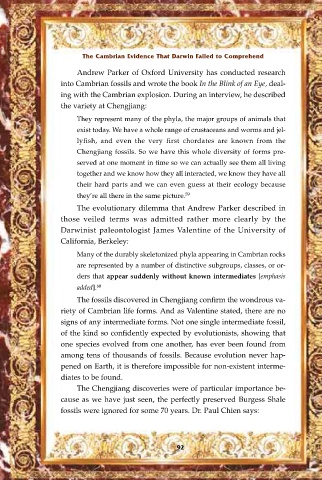Page 94 - The Cambrian Evidence that Darwin Failed to Comprehend
P. 94
The Cambrian Evidence That Darwin Failed to Comprehend
Andrew Parker of Oxford University has conducted research
into Cambrian fossils and wrote the book In the Blink of an Eye, deal-
ing with the Cambrian explosion. During an interview, he described
the variety at Chengjiang:
They represent many of the phyla, the major groups of animals that
exist today. We have a whole range of crustaceans and worms and jel-
lyfish, and even the very first chordates are known from the
Chengjiang fossils. So we have this whole diversity of forms pre-
served at one moment in time so we can actually see them all living
together and we know how they all interacted, we know they have all
their hard parts and we can even guess at their ecology because
they’re all there in the same picture. 59
The evolutionary dilemma that Andrew Parker described in
those veiled terms was admitted rather more clearly by the
Darwinist paleontologist James Valentine of the University of
California, Berkeley:
Many of the durably skeletonized phyla appearing in Cambrian rocks
are represented by a number of distinctive subgroups, classes, or or-
ders that appear suddenly without known intermediates [emphasis
added]. 60
The fossils discovered in Chengjiang confirm the wondrous va-
riety of Cambrian life forms. And as Valentine stated, there are no
signs of any intermediate forms. Not one single intermediate fossil,
of the kind so confidently expected by evolutionists, showing that
one species evolved from one another, has ever been found from
among tens of thousands of fossils. Because evolution never hap-
pened on Earth, it is therefore impossible for non-existent interme-
diates to be found.
The Chengjiang discoveries were of particular importance be-
cause as we have just seen, the perfectly preserved Burgess Shale
fossils were ignored for some 70 years. Dr. Paul Chien says:
92

